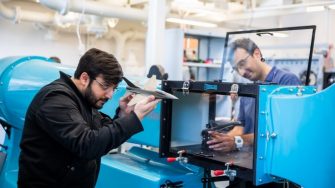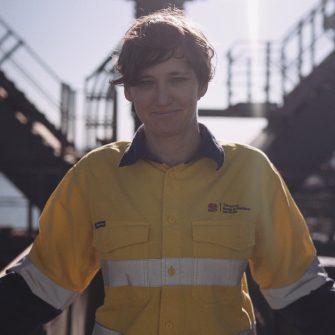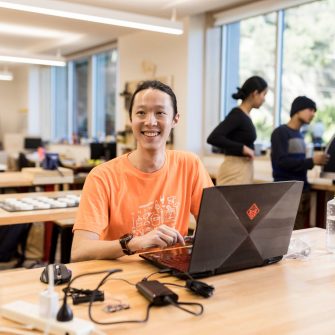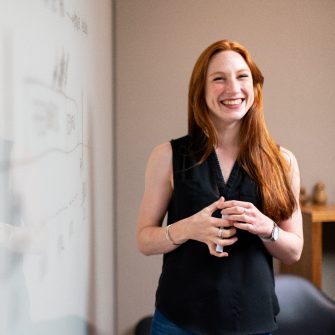Bachelor of Engineering (Honours) (Aerospace Engineering)
- Commencing Terms
- Term 1, 2 & 3
- Duration
- 4 Year(s)
- Delivery Mode
- Face-to-face (includes blended)
- Campus
-
Kensington
- Codes
- UAC code 425050
- Program code 3707
- CRICOS code 056835E
-
ATAR/2025 lowest selection rank
- 92.0 View all admission criteria
-
2026 Indicative first year full fee
- $8,000*
-
2026 Indicative full fee to complete degree
- $37,500*
-
2026 Indicative first year full fee
- $61,500*
-
2026 Indicative full fee to complete degree
- $265,500*

Application closures for 2026
International applications for all undergraduate programs, as well as postgraduate programs offered by the faculties of Arts, Design & Architecture, Engineering (excluding Master of Information Technology and associated programs) and Science are now closed to New Overseas Student Commencement (NOSC) for 2026 intakes.
Postgraduate programs offered by the Business School and the faculties of Law & Justice and Medicine & Health remain open. Master of Information Technology (and associated programs) also remain open.
- Overview
- Entry requirements
- What will I study?
- Future careers
- Double degrees
- How to apply
- Fees & Scholarships
Overview
This exciting degree focuses on the science and practice of air and space flight; the design, development, testing and production of aerospace vehicles; the maintenance and operation of aircraft; and aerospace research. To accommodate the international nature of the aerospace industry, you will receive the same depth of understanding as professional aerospace training programs in other industrial countries.
Our Aerospace Engineering degree focuses on airborne vehicles to meet future employment prospects in Australia (like aerodynamics, flight mechanics, propulsion and structures). The final-year course involves a team project integrating all aspects of aircraft design to meet a defined mission specification. To get you work ready, you'll apply your skills through 60 days of approved industry training.
Why study at UNSW?
Engineering at UNSW is known as a leader in engineering education and research. We’ve invested in this standing with a $1 billion refurbishment of our engineering facilities. We're ranked #1 in Australia and #25 globally for Engineering and Technology. As well as this, all of UNSW's Engineering schools are ranked in the global top 50 with two schools ranked in the global top 10 for Engineering subjects (QS World University Rankings by Subject, 2025).
On top of that, we're ranked #1 in Australia for Mechanical, Aeronautical and Manufacturing Engineering (QS World University Rankings by Subject, 2025).
Benefits of studying with us:
- UNSW is known for its graduate employability, with UNSW awarded the Most Employable students for six years in a row (Australian Financial Review (AFR) Top100 Future Leaders Awards, 2020–2025)
- Strong partnerships with industry in education, research, training and employment
- Learn and explore in best-in-class teaching labs and cutting-edge facilities which have just undergone a $67 million refurbishment including the Willis Annexe and Ainsworth Building
- Our facilities including a flight simulator, mechatronics research space, a refrigeration lab, six laser labs, machines for tensile and compression testing, an aerodynamics laboratory with four wind tunnels and mechanical workshop
- Study options that allow you to gain practical engineering skills working on multidisciplinary and collaborative projects and practical design courses in our ChallEng program.
Take part in interactive learning through the ChallEng program. The ChallENG program connects students, academics and companies to exciting, real-world projects and learning-based initiatives. The program will prepare you for your future career by helping develop technical and design skills and expanding your professional expertise.
At UNSW Engineering you’ll benefit from a diverse and welcoming community with plenty to keep you busy. UNSW Engineering boasts 16 student societies including a society for each school. Get involved in Queer Students in Stem, Women in Renewable Energy Society or Robogals. UNSW’s Women in Engineering (WIE) society runs social and industry events as well as programs designed to mentor and develop female engineers.
3707
056835E
Kensington
425050
192
Want to see more from UNSW Engineering?
Entry requirements
92.0
15.0
36.0
80.65*
-
- The 2025 Lowest Selection Rank (LSR) is the adjusted rank (ATAR plus adjustment factors) you would have needed to gain entry to this degree in 2025.
- The 2025 A levels score is based on four Advanced Level (A2) subjects. Entry scores are calculated from the best three or four A2 subjects (excluding repeated subjects) using the following values: A*=6, A=5, B=4, C=3, D=2, E=1. At most one Applied A Level subject may be included in the best four subjects used to calculate the aggregate.
- The 2025 IB Diploma is an indication of the IB you would have needed to gain entry to this degree in 2025. It is to be used as a guide only.
- The 2025 Lowest ATAR is the lowest ATAR (before adjustment factors were applied) to which an offer was made. Where <5 is listed, this indicates that less than 5 ATAR-based offers were made and so the score has not been published. N/A indicates no offers were made on the basis of ATAR.
*The Lowest ATAR to which an offer was made, for this program, is based on a UNSW Gateway Early Conditional Offer.
-
At UNSW, we are committed to ensuring prospective students have all the information they need in order to make informed decisions about their study options.
To assist you in gaining a better understanding of how Admissions works at UNSW, we have provided you with a summary of ATAR offers and the student profile.
We hope this information will help you identify the degree that is right for you.
Assumed knowledge
Mathematics Extension 1, Physics.
Adjustment Factors
We offer a range of adjustment factor schemes that reward students for academic performance and extra-curricular achievements. These schemes also take into account a range of personal and educational disadvantages that may have affected your studies.
HSC Plus
This scheme rewards students who perform well in Year 12 subjects that are relevant to their preferred UNSW degree. You may be awarded up to five points.
Elite Athletes, Performers and Leaders (EAPL)
This program recognises achievements in the areas of sport, academia, leadership and music at an elite level. You may be eligible for up to five points.
Educational Access Scheme (EAS)
Factors such as illness, financial hardship, language difficulties or attending a particular school can mean you don't always get the best possible marks in Years 11 and 12. If one of these situations applies to you, submit an application for the Educational Access Scheme (EAS) via UAC. Eligible students can receive between 1 and 10 points towards their chosen UNSW degree.
Admission pathways
This degree is eligible for admission through our Portfolio Entry Early Conditional Offer Scheme. Complete a submission to demonstrate your passion and performance in relevant subjects. Successful applicants will receive an early conditional offer with an adjusted ATAR entry requirement.
English language requirements
You may be asked to provide evidence of your English proficiency to study at UNSW depending on your educational background and citizenship. English language skills are vitally important for coping with lectures, tutorials, assignments and examinations - this is why UNSW requires a minimum English language competency for enrolment.
If you’re completing an Australian Year 12 qualification (e.g. NSW HSC or equivalent), you do not need to provide anything extra to prove your proficiency. Your qualification will be used as evidence of your English proficiency.
If you do need to provide evidence of your English proficiency, this will be indicated in your application. You can prove this by providing evidence that you meet one or more of the following criteria:
- English language tests and university English courses
- Prior study in the medium of English
- Other qualifications
If you need to improve your English skills before you start your degree, UNSW College’s Academic English Programs are for you. The programs are suitable for various English levels and help you prepare for university studies and life in Australia.
For more details, visit the English Language Requirements page.
International direct entry
Information for applicants with CBSE, HKDSE or Singapore A Levels Qualification
Calculating your CBSE Score:
Awarded by CBSE, average percentage marks across English or Hindi, and your best four remaining subjects. Where marks are given as a range, the mid-point for that range is used e.g. 75 to 80 = 77.5.
Calculating your HKDSE Score:
Entry requirements are based on the aggregate of the best 5 achieved category A subjects (category B and C subjects are not considered).
For subjects other than Citizenship and Social Development: level 5**=7 points, level 5*=6 points, level 5=5 points, level 4=4 points, level 3=3 points, level 2=2 points, level 1=1 point, Level U=0 point.
For subject Citizenship and Social Development: Attained=2 points, Unattained=0 point. Citizenship and Social Development will only be counted towards the aggregate if the 2 points awarded for Attained ranks among the student’s best five scoring subjects.
If Mathematics Compulsory Part and Extended Part (Module 1 or 2) are both presented, both scores can be counted.
Calculating your Singapore A Levels:
Due to significant changes to the GCE A-Level Curriculum and University Admissions Score (UAS) calculation effective 2026, UNSW assessment is currently under review.
Note: Entry requirements published on this page are correct as of the day of publication and may change without notice.
We do not accept secondary qualifications from this country. We may accept tertiary study results, please contact us for more information.
Please contact us for direct entry requirements.
Assumed knowledge
Mathematics Extension 1, Physics
Admission pathways
If you do not meet the requirements for direct entry into your chosen degree, you may be eligible for a pathway program with UNSW College. UNSW College provides alternative entry options using university-approved content so that you can start your UNSW journey with confidence.
English language requirements
You may be asked to provide evidence of your English proficiency to study at UNSW depending on whether you are from an English-speaking background or non-English speaking background. English language skills are vitally important for coping with lectures, tutorials, assignments and examinations - this is why UNSW requires a minimum English language competency for enrolment.
If English is not your first language, you’ll need to provide proof of your English proficiency before you can be given an offer to study at UNSW. You can do this by providing evidence that you meet one or more of the following criteria:
- English language tests and university English courses
- Prior study in the medium of English
- Other qualifications
If you need to improve your English skills before you start your degree, UNSW College’s Academic English Programs are for you. The programs are suitable for various English levels and help you prepare for university studies and life in Australia.
For more details, visit the English Language Requirements page.
Check the specific English language requirements for this program
What will I study?
UNSW is introducing a new academic calendar from 2028.
We are moving to a new flex-semester calendar. What does this mean for your studies?
Program structure
Our Aerospace Engineering degree focuses on airborne vehicles to meet future employment prospects in Australia (like aerodynamics, flight mechanics, propulsion and structures).
From your first year, you’ll build your knowledge in the design, development, testing and production of aerospace vehicles. In your final year, a team project integrates all aspects of aircraft design to meet a defined mission specification.
You’ll choose from electives taught by leading academics including:
- Aerospace design
- Mechanics of Fracture and Fatigue
- Advanced Aerospace Propulsion
- Maker Games
- Solar Thermal Energy Design
- Wind Energy Converters
- Sustainable Energy for Developing Countries
- Grand Challenges for Engineering
- Engineering Mechanics
Minor in Nuclear Engineering
In this degree, you can choose to study a minor in Nuclear Engineering. With a UNSW Minor in Nuclear Engineering, you will be able to apply your degree expertise to work on energy efficiency, material improvements, defence technology, and crucial nuclear medicine for Australia. Find out more.
Minor in Humanitarian Engineering
In this degree, you can choose to study a minor in Humanitarian Engineering*. With this minor, you will develop the ability to address problems in disadvantaged communities and societies around the world. Combine your skills as an engineer with skills in humanitarian practice to address problems relating to inequities and lack of access to essential services.
*Not available in all specialisations, course substitutions may apply when choosing to study this minor as part of this degree.
-
- Aerospace Engineering
Full program structure
Degree structures can vary depending on the number of courses you choose and timetabling, to give you an indication you can consider the below.
In your first year you might study:
Two introductory courses in Mathematics
An introductory course in Physics,
and an introductory course in Computing
You may also study an introductory course related to your specialisation of choice. These courses equip you with the skills required for the rest of your Engineering degree.
All students study ENGG1000 “Introduction to Engineering Design and Innovation”. In this course you’ll learn to think the way that engineers think, developing solutions with limited budget, time and resources.
In your second year you’ll undertake:
Courses from your selected specialisations
Core courses to give you the fundamental knowledge in your area of interest
In your third and fourth year you’ll develop your knowledge further with a range of core and elective courses.
During your degree you’ll be required to complete two General Education electives. These courses help you broaden your education by completing several courses from outside the engineering faculty strengthening your cross-disciplinary thinking, developing a flexible approach and enhancing your critical analysis skills.
In this degree, you can choose to study a minor in Nuclear Engineering. With a UNSW Minor in Nuclear Engineering, you will be able to apply your degree expertise to work on energy efficiency, material improvements, defence technology, and crucial nuclear medicine for Australia. Find out more
This degree also requires you to complete 60 days of industrial training, which gives you some on the job experience before graduating. This multidisciplinary educational approach connects students, academics and industry enabling you to develop the essential technical and professional skills, so you thrive in your future career.
Future careers
The Aerospace industry is one of Australia’s major exporters of high value-added manufactured goods. Aerospace Engineers use their expertise to design, manufacture and operate flight vehicles but their careers are far more diverse than this sounds.
Choosing aerospace engineering as your specialisation offers you a range of career possibilities. The skills you’ll develop is this degree can be used in a range of industries and are highly sought after industries like automotive and power. Aerospace Engineers that graduate from UNSW can go on to work in design offices, on the manufacturing, testing and repair of aircraft, in regulatory and certification authorities, in defence organisations, in research, in software development companies and much more
Potential careers
- Space industry
- Consulting
- National security
- Transportation
- Airlines
- Maritime construction
Accreditation
This degree is globally recognised and is accredited by Engineers Australia and acknowledged by the Washington Accord.
Part of this degree involves applying your skills through 60 days of approved industrial training in Australia or overseas. Your industrial training will give you a taste of a real-world professional engineering setting and the hands-on experience to become career-ready.
Double degrees
Combine your talent and passion and embark on opportunities designed for your unique strengths. Despite the name, double degrees are not double the workload! You'll study core courses in two areas of expertise, graduating with two qualifications in less time than it takes to complete two consecutive degrees.
Double your knowledge, skills, and career options with the Bachelor of Engineering (Honours) and:
- Advanced Mathematics (Honours)
- Advanced Science (Honours)
- Arts
- Commerce
- Computer Science
- Engineering Science
- Fine Arts
- Law
- Science
*Double Degree only available with some Bachelor of Engineering (Honours) specialisations
How to apply
Applications for undergraduate study from domestic students (Australian citizens, Australian permanent residents, Australian permanent humanitarian visa holders and New Zealand citizens) are processed by the Universities Admissions Centre (UAC).
Visit the Apply section of the UAC website and you can nominate up to five degrees in order of preference, with the first being your most desired degree and university.
On-time applications for admission usually close at the end of September each year for Term 1 admission. Late applications can be submitted, but a late fee will apply. For study starting in Term 1, the majority of offers are made in December and January. Visit the UAC website for key dates for admission outside of Term 1.
Ready to start your application?
For most international students, applications are submitted via our Apply Online service. We encourage you to submit your completed application as early as possible to ensure it will be processed in time for your preferred term.
Some high-demand programs with limited places, may have an earlier application deadline or may have an earlier commencement date. For details, visit the international admissions information page.
*If you are an international student studying an Australian qualification, go to the Universities Admission Centre (UAC) for application and UAC key dates. Note: If you are under 18 years of age, you need to make special arrangements. For details, visit the under 18 international students page.
Ready to start your application?
Fees & Scholarships
Commonwealth Supported Place: Student Contribution Band 2
*The student contribution for a Commonwealth Supported Place is an indication only of the amount payable in Year 1 based on a standard full-time load of 48 credit points (1.0 EFTSL). The actual student contribution you will be liable for depends on your individual program of study and the calendar year in which you enrol. Actual fees are calculated upon enrolment. Student contribution amounts are subject to annual review by the university and may increase each year during your studies (subject to caps determined by the Australian Government), effective at the start of each calendar year.
The indicative fees listed here are based on an estimated average and are for tuition only - other fees and charges are not included.
*Fees are subject to annual review by the University and may increase annually, with the new fees effective from the start of each calendar year. The indicative fees listed here are based on an estimated average and are for tuition only, other fees and charges are not included. The amount you pay will vary depending on the calendar year to enrol, the courses you select and whether your study load is more or less than 1 Equivalent Full Time Student Load (8 courses per year).
Indicative fees are a guide for comparison only based on current conditions and available data. You should not rely on indicative fees. More information on fees can be found at the UNSW fees website.
Indicative fees to complete the program have been calculated based on a percentage increase for every year of the program. Fee increases are assessed annually and may exceed the indicative figures listed here.
Indicative fees to complete the program include tuition plus an estimate of study-related costs of approximately $1,000 per year. To find out more about other costs, visit UNSW International.
Scholarships
At UNSW, we award over $83 million in scholarships each year. We pride ourselves on rewarding excellence and making university accessible to students from all walks of life. Whether you’re a domestic or international student, our range of scholarships, prizes and awards can support your journey.
Featured scholarships
Women in Engineering Scholarships
UNSW provides a wide range of Women in Engineering scholarships to support high-achieving female students throughout their degree. Apply here and search for ‘Engineering’ in the keywords.
Progress starts here – at a world-leading university

Top 20 Worldwide
Ranked in the global top 20 for three consecutive years
QS World University Rankings, 2024–2026

Winner of the AFR Most Employable University Award six years in a row
AFR Top100 Future Leaders Awards, 2020–2025

Australia's #1 for Innovation
Highest number of startups and spinouts from university-developed tech
SCOPR report, 2024





